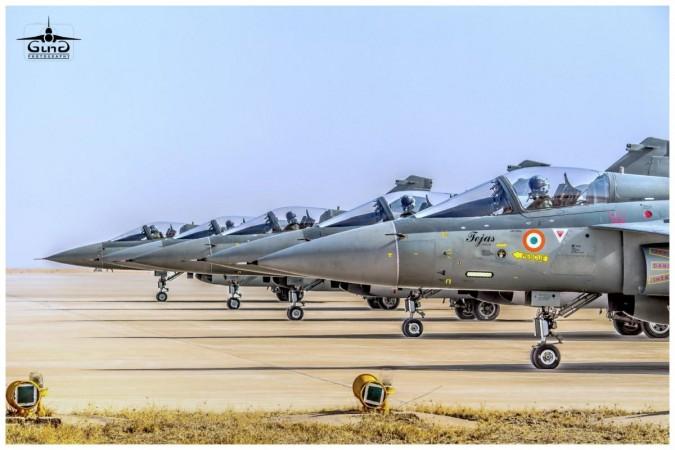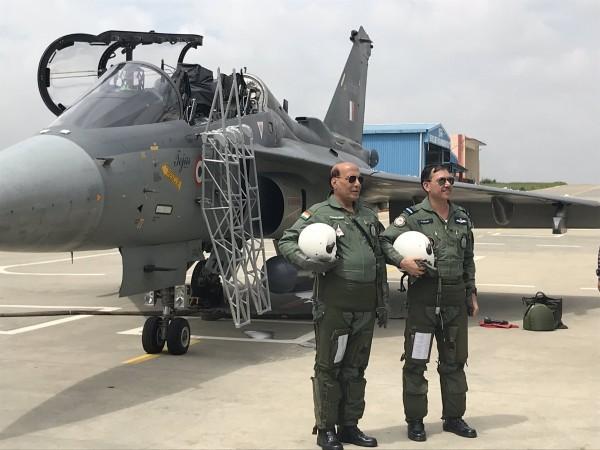The CCS chaired by PM Sh. Narendra Modi today approved the largest indigenous defence procurement deal worth about 48000 Crores.
This will strengthen IAF's fleet of homegrown fighter jet 'LCA-Tejas'. This deal will be a game-changer for self-reliance in the Indian defence manufacturing said Rajnath Singh India's Defence Minister.
Indian single-engine, fourth-generation, multirole light fighter designed by the Aeronautical Development Agency (ADA) in collaboration with Aircraft Research and Design Centre (ARDC) of Hindustan Aeronautics Limited (HAL) for the Indian Air Force and Indian Navy. It comes from the Light Combat Aircraft (LCA) programme, which began in the 1980s to replace India's ageing MiG-21 fighters. In 2003, the LCA was officially named "Tejas."
Numerous changes & improvements caused huge massive delays. Almost after 40 years of work, the latest version of the aircraft was accorded final operational clearance (FOC) by India's aviation certifying authority in February 2019.

The fighter is from a comparable weight range to the Swedish Gripen and Pakistani JF-17 fighter and is considerably lighter than higher-end single-engine designs such as the American F-16 Fighting Falcon and Chinese J-10 Firebird.
The Indian Air Force has planned for a total of 300 plus Tejas aircraft in several variants.
The first batch of 40 Mark 1 aircraft consists of 16 Initial Operational Clearance (IOC) standard that was delivered in early 2019. The delivery of the second batch of 16 Full Operational Clearance (FOC) standard aircraft commenced in late 2019 and led to the formation of the second Tejas squadron — in May 2020. The IAF will receive eight twin-seat trainers. The 83 are to be to the upgraded Mark 1A standard.
The Tejas Mark 2 is expected to be ready for series production by 2025–26.
IAF's new Tejas fleet
On 7 November 2016, the then Defence Minister of India Shri Manohar Parrikar had approved the procurement of 83 numbers of Tejas for the Indian Air Force.
While the Defence Acquisition Council had approved the deal for about 39,000 crore in March 2020, the deal value now approved now stands at about at a cost of ₹48,000 crore.

While stated to be an indigenous program, many of the Tejas' core systems are purchased off the shelf from foreign suppliers including an American F404 engine - the same as that designed to power the F-20 Tigershark light fighter in the 1970s, an Israeli sensor suite and electronics, and Russian air to air missiles.
Gen Rawat said induction of Tejas jets will help India emerge as a key defence exporter.
The Indian Air Force's long-delayed plan to buy over 100 foreign-designed fighters had made little progress in the past over two decades.
The latest iteration of the plan came in April 2018, when the Indian Air Force formally launched a process to buy 114 fighters in a deal estimated to be worth around $15 billion. The Indian Air Force was also simultaneously negotiating with HAL to buy 83 units of the indigenously designed Tejas fighter at an estimated cost of $6 billion.
The Indian Air Force had already ordered 40 Tejas jets from HAL.
Huge push for Make In India
Chief of Defence Staff General Bipin Rawat indicated that the Indian Air Force was "switching" to the Tejas in place of foreign options. "We would rather take the indigenous fighter, it is good, the induction of additional Tejas fighters will help India emerge as a key exporter of defence equipment, especially in view of its relatively low price".

He also mentioned about the proposed move to buying indigenous fighters as a "shift to start using locally made weaponry and mentioned that "the defence forces will now onwards be ordering more of locally produced goods, and whereas there is a realisation that there may be some quality issues in the beginning, but these will be gradually improved."
Gen Bipin Rawat had stated his priority for indigenous combat equipment. While pushing for Tejas he had also mentioned "even the artillery guns, air defence systems and radars will all be indigenous systems as well. We are doing well with artillery guns and in air defence systems. We are also looking at ammunition manufacturing in our country in a very big way."
A possible switch to the Tejas in place of foreign fighters would be considered a major change in priority for the Indian Armed Forces.
It is well known that seven aircraft were in contention for the contract for 114 fighters. These included a customised version of the US-designed F-16 called the F-21 and the French Dassault Rafale.

In 2015, the Narendra Modi government opted for an outright purchase of mere 36 Rafale fighters from France only to meet emergency requirements.
In 2017, though it was reported that the Indian Air Force had complained that the Tejas in its current configuration was "far behind" competitors like the F-16 and the Swedish Gripen. The Indian Air Force had also mentioned about parameters such as issues with aerial endurance and weapons load and higher maintenance costs of the Tejas, however, these seem to have been factored.
The 83 Tejas jets the Indian Air Force is buying will be of an improved MK1A configuration, which will have more capable electronics, radar and air-to-air refuelling capability.
In addition, the DRDO is working on an advanced version of the Tejas, which was initially called the Tejas Mk2.
In 2019, the Tejas MK2 project was renamed the Medium Weight Fighter. The Medium Weight Fighter will have design enhancements, a higher-thrust engine and more weapons carriage capability. However, the Medium Weight Fighter is expected to fly only by 2025.
Disclaimer: This is a guest post by Major General Dilawar Singh (Retd.), Senior Vice President of the Global Economist Forum ECOSOC, UN. He is the former Director-General NYKS at Ministry of Youth Services and sports. He was also Additional Director General of Rashtriya Rifles, has served six tenures in counter-terrorist areas, commanded two Counter-Terrorist Balallions and is the only officer to have received three citations therein. He holds unbroken records for academic and operational excellence as well as long-term planning for the Indian Army.









